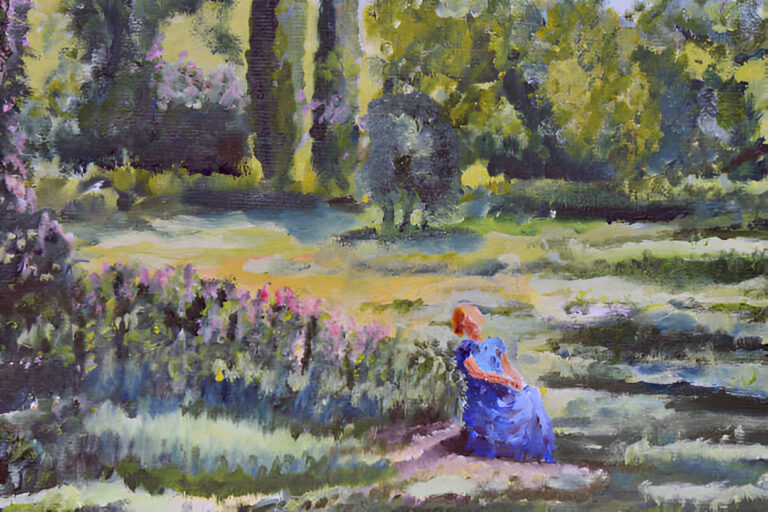Introduction to Claude Monet’s Artistic Journey
Claude Monet, a pioneering figure in the world of art, is often celebrated as the father of Impressionism, a movement that transformed how art was perceived in the late 19th century. His work has inspired generations of artists, leaving an indelible mark on art history. Monet’s ability to capture fleeting moments of light and nature in a way that evokes emotion and awe is one of the many reasons his art remains so captivating to this day.
Monet’s Early Life and Influences
Born in 1840 in Paris, Monet showed an early interest in drawing and painting. His upbringing in Le Havre, surrounded by the beauty of the Normandy coastline, greatly influenced his love for nature. Early in his career, Monet was introduced to the Barbizon School of landscape artists, who favored painting outdoors to capture the changing effects of light. These early experiences paved the way for his groundbreaking contributions to the Impressionist movement.
The Birth of Impressionism
Monet’s Role in the Impressionist Movement
Monet’s most famous painting, Impression, Sunrise (1872), gave birth to the term “Impressionism” after a critic mockingly used it to describe the piece’s unfinished appearance. However, the term stuck, and Monet, along with other artists like Renoir, Degas, and Pissarro, embraced it. The Impressionist movement broke away from traditional art forms, focusing on light, color, and capturing moments rather than precise details.
Techniques and Styles Monet Perfected
One of Monet’s greatest innovations was his use of light and color. He often painted the same scene multiple times to capture it in different lighting conditions. His series of paintings, such as Haystacks, Rouen Cathedral, and Water Lilies, showcase his fascination with light and its impact on the perception of color. Monet’s technique of applying short, quick brushstrokes created a sense of movement, making his paintings feel alive and dynamic.
Iconic Works of Claude Monet
Monet produced hundreds of masterpieces throughout his career, but a few stand out as iconic representations of his genius:
1. Impression, Sunrise
This painting, which sparked the Impressionist movement, depicts the harbor of Le Havre at sunrise. The loose brushwork and play of light are characteristic of Monet’s style, offering a fresh perspective on traditional landscape painting.
2. Water Lilies Series
Perhaps his most famous work, the Water Lilies series, was created during the last 30 years of his life. Monet constructed a Japanese-inspired water garden at his home in Giverny, where he spent countless hours painting the reflections of clouds and flowers on the pond’s surface. The soft, dreamlike quality of these paintings makes them some of the most beloved works in art history.
3. Woman with a Parasol
Painted in 1875, this work captures Monet’s wife and son walking in a field. The wind gently rippling through the grass and the airy clouds above showcase Monet’s talent for conveying movement and atmosphere in his art.
Monet’s Influence on Modern Art
Monet’s influence extends far beyond his lifetime. His emphasis on color, light, and atmosphere changed the course of art history, paving the way for artists such as Vincent van Gogh, Paul Cézanne, and Jackson Pollock. His work challenged the conventions of academic art, encouraging artists to experiment with form and perception. Monet’s focus on capturing a moment in time resonates with modern photography and digital art, illustrating how his revolutionary ideas remain relevant in contemporary art.
Monet’s Later Years and Legacy
The Giverny Years
In 1883, Monet settled in Giverny, where he lived and worked for the rest of his life. His garden became his primary subject, inspiring some of his most famous works. Despite suffering from cataracts in his later years, which affected his ability to see colors clearly, Monet continued to paint prolifically until his death in 1926.
Monet’s Lasting Impact on the Art World
Monet’s work has continued to gain recognition long after his death. Exhibitions of his paintings draw millions of visitors worldwide, and his works are housed in prestigious museums such as the Musée d’Orsay in Paris and the Metropolitan Museum of Art in New York. The values of his paintings have skyrocketed at auctions, cementing his place as one of the most influential artists of all time.
Where to Purchase Monet’s Art
For art enthusiasts looking to bring a piece of Monet’s brilliance into their own homes, there are several options available. From high-quality reproductions to prints, Monet’s works are widely accessible for both collectors and admirers. You can purchase Monet’s art through various online galleries, including those specializing in museum-quality reproductions of his most famous paintings.
How to Appreciate Monet’s Art in the Modern Age
Tips for Viewing Monet’s Art
To fully appreciate Monet’s works, consider the following when viewing his paintings:
- Focus on Light and Color: Monet’s mastery of light is best appreciated up close. Notice how different times of day and weather conditions change the mood of his paintings.
- Observe the Brushstrokes: Monet’s technique of short, choppy brushstrokes can be seen clearly when viewing his work in person. Step back and see how these strokes come together to form a cohesive image.
- Pay Attention to Repetition: Many of Monet’s series, like Haystacks or Water Lilies, feature the same subject repeated under different lighting conditions. This repetition allows viewers to see how light transforms color and mood.
Conclusion: The Timeless Appeal of Monet’s Masterpieces
Claude Monet’s contributions to the world of art are immeasurable. His innovative techniques, emphasis on light and color, and passion for capturing the beauty of nature have left an enduring legacy. Today, his works continue to inspire both art lovers and creators, transcending time and trends. Whether it’s through a museum visit or the decision to purchase a reproduction, Monet’s art offers an unparalleled glimpse into the world as seen through the eyes of a true master.



